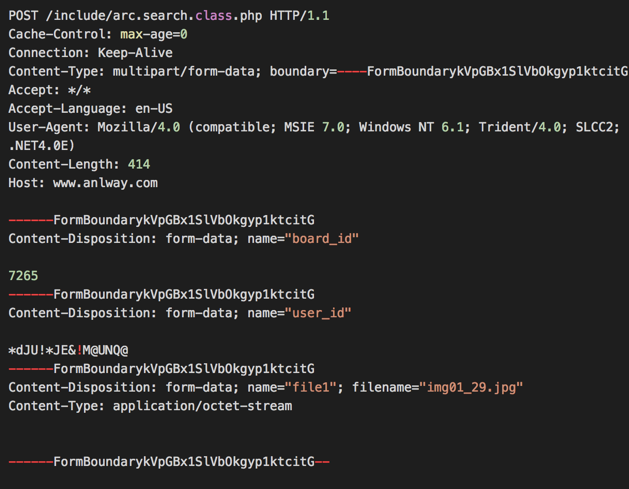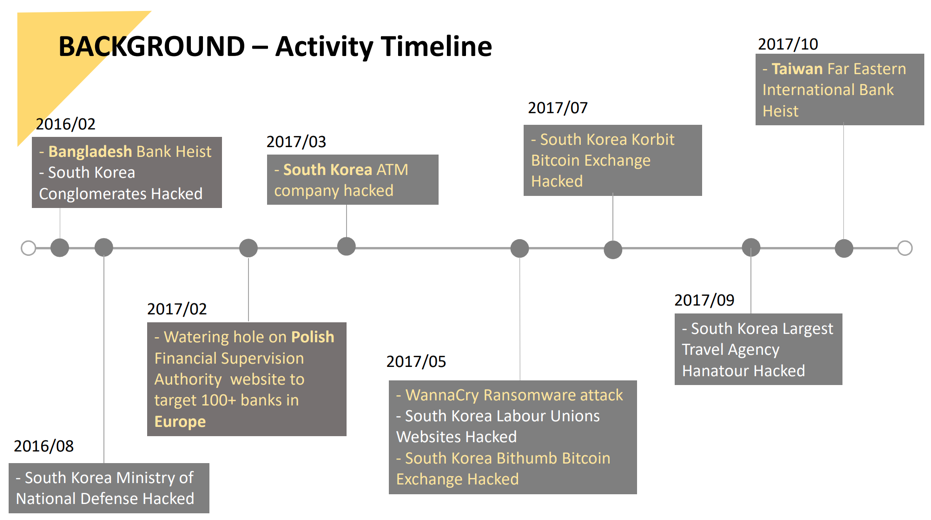By Chris Doman, Fernando Martinez and Jaime Blasco
We took a brief look at some documents recently discussed and reviewed by researchers in South Korea over the past week. The malware is linked to Lazarus, a reportedly North Korean group of attackers. One malicious document appears to be targeting members of a recent G20 Financial Meeting, seeking coordination of the economic policies between the wealthiest countries. Another is reportedly related to the recent theft of $30 million from the Bithumb crypto-currency exchange in South Korea.
This article stands very much on the shoulders of other work by researchers in South Korea. Credit for initially identifying these documents goes to @issuemakerslab, @_jsoo_ and others.
Malicious Documents
We looked at three similar malicious documents:
-
국제금융체제 실무그룹 회의결과.hwp ("Results of the international financial system working group meeting") - cf09201f02f2edb9c555942a2d6b01d4
- 금융안정 컨퍼런스 개최결과.hwp ("Financial Stability Conference held") - 69ad5bd4b881d6d1fdb7b19939903e0b
- 신재영 전산담당 경력.hwp (“[Name] Computer Experience”) - 06cfc6cda57fb5b67ee3eb0400dd5b97
The decoy document, mentioning the G20 International Financial Architecture Working Group Meeting
The decoy document of a resume
These are Hangul Word Processor (“HWP”) files - a South Korean document editor. The HWP files contain malicious postscript code to download either a 32 or 64 bit version of the next stage from:
- https://tpddata[.]com/skins/skin-8.thm - eb6275a24d047e3be05c2b4e5f50703d - 32 bit
- https://tpddata[.]com/skins/skin-6.thm - a6d1424e1c33ac7a95eb5b92b923c511 - 64 bit
The malware is Manuscrypt (previously described by McAfee and others), and communicates by impersonating South Korean forum software:
These samples communicate with:
- https://www.anlway[.]com/include/arc.search.class.php
- https://www.apshenyihl[.]com/include/arc.speclist.class.php
- https://www.ap8898[.]com/include/arc.search.class.php
Is this related to the recent Bithumb heist?
If you follow cryptocurrency, you may have heard about some thefts reported this month for South Korean cryptocurrency exchanges:
Report from the Guardian
Reports within South Korea have suggested the the thefts from Bithumb started with malicious HWP files earlier in May and June. They also mentioned they are linked to previous attacks by Lazarus, and involved faked resumes.
A report by a South Korean news organisation into the investigation by a South Korean security company into the thefts shows some very familiar looking malware samples that were sent to cryptocurrency organisations:
Screen-stills from a KBS news report
Whilst we can’t be certain this malware is responsible for the thefts from Bithumb, it seems a likely suspect.
Other Campaigns
There were earlier reports of related malicious HWP documents from Lazarus targeting crypto-currency users in South Korea earlier this month. In that case, we noticed there are a number of crypto-currency phishing domains that are registered to the same phone number as a domain (itaddnet[.]com) used to deliver some of the malware.
It may be that the attackers are phishing for credentials, in addition to delivering malware:
A forum discussion by South Korean crypto-currency users discussing a phishing attack from the domain coinoen[.]org
It is unusual to see Lazarus registering domains - normally they prefer to compromise legitimate websites. So this would be an unusual attack if it is indeed run by members of Lazarus.
Historical Attacks
If the attackers behind the Bithumb heist are indeed Lazarus - they were likely aided by knowledge from a previous hack. They were linked to a theft of $7 million from Bithumb cryptocurrency exchanges, back in 2017:
Some selected attacks by different sub-groups of Lazarus, from "APT Attacks Targeting Financial Institutions" by Ashley Shen, Kyoung-ju Kwak and Min-Chang Jang
These attacks are part of a a large number of attacks against banks, including the attempted theft of $1 billion dollars from the Bank of Bangladesh, attacks against ATM networks. They are also well known for the WannaCry and Sony Pictures attacks.
It’s clear that the thefts from Lazarus won’t stop anytime soon given the gains available - the (partially successful) attempt to steal $1 billion dollars from the Bank of Bangladesh represents 3% of North Korea’s reported GDP. Thefts from South Korean organisations have the double impact of weakening their closest competitor.
Just earlier this month, there were reports that Lazarus stole $10 million dollars from a Chilean bank - and destroyed thousands of computers in the process of covering their tracks.
Appendix
Additional indicators are available in our OTX Pulse.
File-Hashes
596fbdf01557c3ec89b345c57ae5d9a0b7251dd8d5a707f7353dd733274c6eb6
58a97c2c731cdf045f26ccc7cba370bd2dfee277a9c43c0421c53593e493f7bc
485f77e5d32de5dc05510743025a75af5b6f714e930e22098490b7afb71b737f
e498630abe9a91485ba42698a35c2a0d8e13fe5cccde65479bf3033c45e7d431
4838f85499e3c68415010d4f19e83e2c9e3f2302290138abe79c380754f97324
2813c0ebcacdcf9052f71d51c81e9c52a16b9a69f8981b2c74eab236524ff4b9
2f4a958b148bef4be10780e8128860cdca21ec26537f51cec8960a9e019aa1f0
4838f85499e3c68415010d4f19e83e2c9e3f2302290138abe79c380754f97324
5b1663d5eb565caccca188b6ff8a36291da32f368211e6437db339ce2dc2e9cd
7985af0a87780d27dc52c4f73c38de44e5ad477cb78b2e8e89708168fbc4a882
afba8105793b635d4ed7febdae4b744826ca8b2381c1b85f5e528bb672ed63c2
c10363059c57c52501c01f85e3bb43533ccc639f0ea57f43bae5736a8e7a9bc8
d8af45210bf931bc5b03215ed30fb731e067e91f25eda02a404bd55169e3e3c3
e98991cdd9ddd30adf490673c67a4f8241993f26810da09b52d8748c6160a292
927120588e6c4e5db5b5a1ea9914cd78a0fa0c9fb558726604747de672c6adf3
e76b3fd3e906ac23218b1fbd66fd29c3945ee209a29e9462bbc46b07d1645de2
3cde54dce88a4544bf5ffa36066a184958d4ff74c2e0ce32fdbf91729c0f574e
Domains
tpddata[.]com
itaddnet[.]com
wifispeedcheck[.]net
Potentially related phishing domains:
coinoen[.]org
coinmaketcape[.]com
bitfiniex[.]org
URLs
https://www.apshenyihl[.]com/include/arc.speclist.class.php
https://www.ap8898[.]com/include/arc.search.class.php
https://www.anlway[.]com/include/arc.search.class.php
https://tpddata[.]com/skins/skin-8.thm
https://tpddata[.]com/skins/skin-6.thm
http://168wangpi[.]com/include/charset.php
http://ando.co[.]kr/service/s_top.asp
http://ansetech.co[.]kr/smarteditor/common.asp
http://mileage.krb.co[.]kr/common/db_conf.asp
http://www.028xmz[.]com/include/common.php
http://www.33cow[.]com/include/control.php
http://www.51up[.]com/ace/main.asp
http://www.530hr[.]com/data/common.php
http://www.97nb[.]net/include/arc.sglistview.php
http://www.anlway[.]com/include/arc.search.class.php
http://www.ap8898[.]com/include/arc.search.class.php
http://www.apshenyihl[.]com/include/arc.speclist.class.php
http://www.marmarademo[.]com/include/extend.php
http://www.paulkaren[.]com/synthpop/main.asp
http://www.shieldonline.co[.]za/sitemap.asp
Network Detection
ETPRO TROJAN Win32/Agent.WTE HTTP CnC Beacon
ETPRO TROJAN Win32/Agent.WTE/Manuscrypt HTTP CnC Beacon








